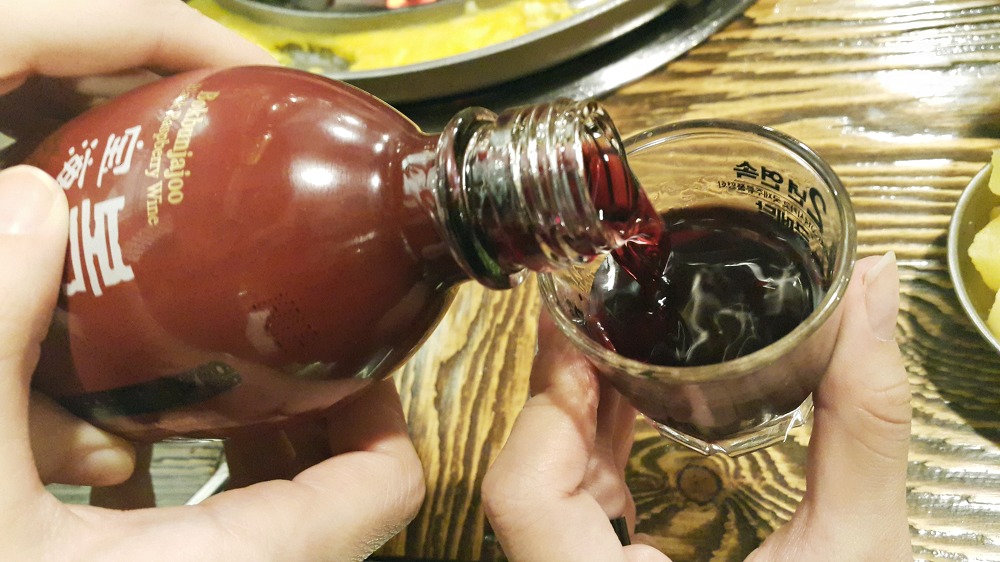Most of us in Singapore are probably familiar with Korean tipples like makgeolli and soju. After all, according to Drinks International, Jinro Soju sells more bottles of soju than any other liquor brand in the world.
However, there are way more Korean alcoholic drinks than just the two mentioned above! Here is a handy guide to soju and makgeolli, as well as some of Korea’s other tipples that you may want to try at your favourite Korean restaurant.
With the exception of makgeolli and beer, alcoholic drinks are commonly served in small shot-glass sizes. Don’t forget to order some anju (food designed to be paired with alcoholic beverages) to go along with your drinks!
Note: Abv refers to alcoholic content, in percentage. As always, you know you have to be of legal age before you drink!
Soju (소주): strong & clear

K-dramas like “Fight for My Way”, in which characters would often get together at a scenic rooftop bar to talk away their youth with a bottle of soju, may have played its part in popularising the drink.
Soju is a popular social lubricant, often drunk neat when dining on barbecued meat or spicy soup. To many first-time drinkers, soju tends to have a very ‘alcoholic’ flavour even at 19-25% abv (vodka is 40%; wine is 12%). Unlike vodka, soju is slightly sweet and the taste can vary considerably – original soju is made primarily with rice, but these days, alternative starches like wheat, sweet potatoes, and tapioca are commonly added.
In recent years, flavoured soju (lemon, peach, grapefruit, etc) has become mainstream. Chamisul (Jinro) is the most popular soju brand, although there are others like Chum Churrum (Lotte) which makes softer soju with a lower abv (18%), and luxury soju brands from the city of Andong made using age-old recipes (abv 20-40%).
Makgeolli (막걸리): light & cloudy

This slightly carbonated milky sweet-tangy tipple is actually Korea’s oldest alcoholic drink, and also the nation’s favourite tipple for when it’s raining (locals often drink makgeolli with pajeon, or scallion pancake). It also features a lot in historic K-dramas (sageuk), where they’re served in a tukbaegi (earthen bowl) with a ladle; in modern dramas, they’re poured from brass kettles into small brass bowls.
Makgeolli (also known as takju and nongju) is a close cousin of Japan’s nigorizake (a cloudy sake) – both are made from rice and brewed (like beer). The major difference is the abv: nigorizake‘s can be high as 20%; makgeolli is watered down to about 4-9% (same as beer). The result is a taste that’s like slightly sweet yogurt.
Once considered a peasant’s drink, the drink is purported to be healthy as it’s low in calories (46 kcal per 100 ml) and contains 10 essential amino acids, vitamin B and C, dietary fibre, and lactic acid bacteria (probiotic) for intestinal health. As with soju, you’ll also find makgeolli flavoured with fruits or honey.
The city of Jeonju is famous for makgeolli, and there are several ‘makgeolli towns’ where the drink is served with a freeflow of side dishes. Jeonju is also home to moju – it’s like makgeolli but boiled with herbs and spices (ie. cinnamon, ginger, ginseng, etc) with 1.5% abv. Another variation is dongdongju, which is basically unfiltered makgeolli with more rice sediments in it.
Cheongju (청주): clear & fragrant

Cheongju (meaning “clear liquor”) is basically the clear liquor residue that’s left after straining makgeolli. As it’s undergone several fermentation stages, it tastes like a mild, slightly sweet sake with a similar abv (14%). Chungha is a popular brand with its clean, crisp and almost savoury taste.
It’s an ancient beverage that was once enjoyed on the royal court – the remaining milky part of the makgeolli was drunk by the commoners. Today, cheongju is often used in a variety of traditional rituals like Jesa (to celebrate Chuseok, which is similar to Qing Ming). It’s also used in cooking.
There are plenty of variants. Baekhaju (백하주) is brewed with glutinous rice and heukmeeju (흑미주) uses black rice. In addition to regional variants (ie. Gyeongju’s beopju), there are different flavours like gukhwaju (chrysanthemum) and insamju (ginseng).
Gwasilju (과실주): sweet & fruity

You may have seen purple/red bottles of bokbunja around, which is made with Korean black raspberry and best paired with seafood dishes. It’s categorised as gwasilju – fruit-based liquor usually made from naturally fermented fruits. There’s also meoruju which is made with Korean grapes.
Some gwasilju are made by mixing fruits and sugars with alcohol to bring out the fragrant, fruity flavours. The most popular is the sweet plum liquor, maesilju, and is basically almost the same as Japanese umeshu. With their sweet taste, gwasilju may be easy to drink, but beware of the 12-19% abv!
Yagyongju (약용주): earthy & herbal

Yagyongju is considered a category of medicinal drink, produced by combining seeds, herbs, and roots with alcohol. They’re generally consumed more for their recreational than their medicinal properties, with an average abv of 14%.
Baekseju – a rice wine infused with 12 herbs – is popular, especially among young people as it tastes less harsh than soju. Another popular yagyongju is Sansachun, a slightly tangy drink brewed from hawthorn berries, which is said to calm the body from a variety of ailments.
Beer

All Korean restaurants will definitely serve another popular social lubricant: beer! Korean beers have a reputation to be light-tasting, especially when compared to European brands.
While not a traditional drink (it was only introduced in the early 20th century), Koreans have 2 major homegrown brands, Hite and Cass, which can easily be found in Singapore. There’s also Kloud, which is fast gaining popularity for its more premium quality, and the newer Terra beer.
A popular way to drink beer in Korea is to drop a shot of soju (in a shot glass) into the beer glass to create a cocktail called somaek, aka a soju bomb.











